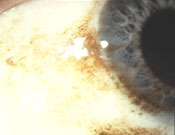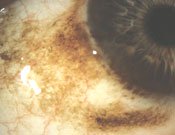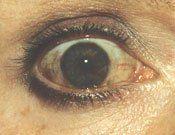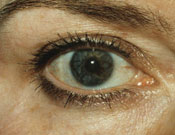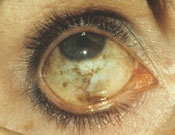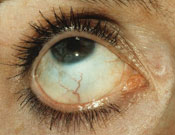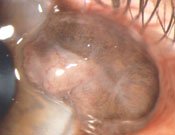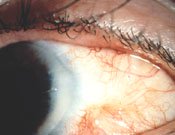Beware of nonpigmented conjunctival melanomas behind melanosis
Frequent follow-up visits and more accurate diagnosis have reduced the number of melanosis patients needing radical operations.
The vast majority of conjunctival melanomas are likely to originate from primary acquired melanosis, tend to be multifocal and require strict lifelong surveillance, according to John Hungerford, MD, of Moorfields Eye Hospital.
“In quite a number of cases, melanosis can be completely nonpigmented and, therefore, very deceptive. A new tumor that appears after a first melanoma has been treated should always raise the suspicion that the patient might have melanosis, even though there is no pigment. A biopsy of what looks like normal conjunctiva will confirm the diagnosis in most cases,” he said.
Conjunctival melanomas are traditionally divided in two groups: the unifocal and the multifocal. Unifocal tumors are said to arise either de novo or in a nevus, while multifocal lesions arise in primary acquired melanosis.
“De novo means that the tumor rose out of a conjunctiva that looked normal. However, since we know that a ‘normal’ conjunctiva might in fact disguise a nonpigmented melanosis, the de novo number is probably overestimated. We also know from recent studies that the nevus might be a stage away from melanosis to melanoma, and therefore the number of multifocal melanomas arising from primary acquired melanosis is probably much higher than we used to think,” Dr. Hungerford said.
Multifocal presentation inevitably leads to frequent development of new tumors, and therefore requires close observation with follow-up examination every 4 to 6 months, he said.
Fluorouracil (5-FU) and mitomycin C have recently been introduced as treatment options for melanosis and have been effective in some cases, Dr. Hungerford noted. However, what appears as a positive result can sometimes be misleading.
“The pigmentation often disappears, and we don’t know whether this means that we have killed the dangerous cells, or whether we have just switched off their ability to produce pigment. In our experience, mitomycin C and 5FU seem to stop or at least delay the onset of new tumors in about half of the patients, but the other half have no benefit at all from the treatment,” he pointed out.
|
Images: Hungerford J |
|
|
|
|
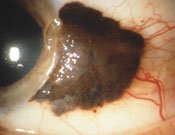 Typical melanoma with prominent feeder vessel. | 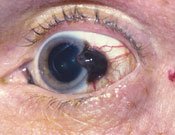 |
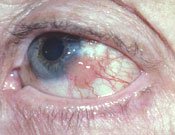 | 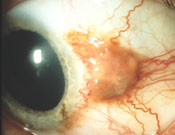 |
| Three melanomas, all of them with feeder vessels but with wide variation in color. | |
Tumor development
The growth of melanoma itself is rapid, and a sudden change in melanosis should always suggest a melanoma, Dr. Hungerford said.
Feeder vessels, he added, are an important sign of melanoma, while the dark pigmentation is not always present.
“Like in melanosis, the pigment expression is variable. Some patients come to us from other doctors who have removed a pale lesion and received a surprise histopathological diagnosis of melanoma,” he said.
The growth pattern of the tumor can also vary, from nodular to superficial spreading, as in skin melanoma.
Tumors arising de novo are always seen in the exposed bulbar conjunctiva within the interpalpberal fissure, according to Dr. Hungerford. For this reason, they might have a similar etiology to melanomas of the skin, as they are in the area that is exposed to light. However, melanomas with origin in primary acquired melanosis commonly occur in unexposed conjunctiva, he explained. Even if not present at the time, melanosis is likely to supervene eventually, and patients with a melanoma in the palpebral conjunctiva or lid skin are therefore at risk of developing new ones.
Melanomas with origin in the caruncle are often not associated with primary acquired melanosis, and have a notably poor prognosis, he said.
“Years ago we used to always exenterate these patients, but now we have a different approach. We excise the lesion and apply additional external beam radiotherapy, with encouraging results in terms of survival rate,” Dr. Hungerford said.
Treatment options
The treatment of conjunctival melanoma is mainly surgical, and depends on site, origin and extent of the lesion. Dr. Hungerford recommended simple excision for melanomas of the bulbar conjunctiva, fornix, plica and caruncle when they are of relatively small size. The larger the tumor, the more generous the excision should be, he said.
When the tumor is at the limbus, lamellar corneoscleral excision with alcohol dissection is the most appropriate surgical method. “These tumors very rarely invade the cornea. By simply lifting off the lesion using a 70% alcohol solution, you can remove the corneal component of the tumor without the need for a graft, and the patient has a wonderful cosmetic result,” he said.
Alcohol loosens the normal adhesion of the conjunctival and corneal epithelium to the underlying structures, and the tumor can be gently removed by lifting it with a surgical knife.
Contrary to what most surgeons do, Dr. Hungerford recommended maintaining a dry surgical field.
“Some apparent relapses of melanomas have in fact developed from cells washed under the conjunctiva by the fluid used during surgery,” he said.
For the same reason he recommended the use of different instruments for handling the tumor and the healthy conjunctiva to prevent the transfer of cancerous cells to the healthy tissue.
“These two little precautions help minimize the risk of surgically induced relapses,” he noted.
“Another thing I always teach my residents is to double evert the upper eyelid at the first visit and every time during the follow up, because the upper fornix is a place where large tumors can hide. Feeling for pre-auricular and submandibular gland enlargement should also be routine practice,” he said.
Adjunctive treatment with radiotherapy or cryotherapy is advised in case of incomplete excision. Mitomycin C and 5-FU therapy has also been recently introduced, but its effectiveness in preventing the onset new tumors is still being evaluated, he said.
|
|
Exenteration
When the tumor is extensive or when multiple recurrences can no longer be controlled, orbital exenteration will be unavoidable, Dr. Hungerford explained.
“It is important to remember that the process of malignant melanoma developing from conjunctival melanosis tends to accelerate over time. The first malignant tumor might develop from conjunctival melanosis after as much as 20 years from the onset of the disease,” he said. “After treatment, nothing happens for about 5 years, but then a progressive acceleration usually takes place. The next tumor may not be one, but two, and the next one might appear 3 months later. When you get to the stage of frequent multifocal recurrences, exenteration is advisable.”
In most cases, the eyelid tissue can be preserved, and with the use of a spectacle-mounted prosthesis, a satisfactory cosmetic result and fast rehabilitation can be obtained.
In the last 5 years, Dr. Hungerford has developed a new technique that also spares the supraorbital nerve and preserves an almost complete sensation in the patient’s forehead.
“The supraorbital nerve is normally severed when cutting the periosteum at the orbital margin. Instead, I identify the nerve and dissect it out to the orbital apex. Although this maneuver prolongs the operation by about half an hour, and is not strictly necessary for tumor control, the patients are very grateful for not suffering the additional impairment of a completely anesthetized forehead,” he said.
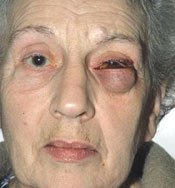 | 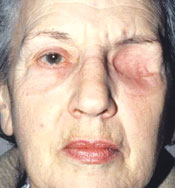 | 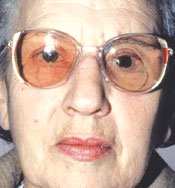 |
| Large eyelid melanoma. Exenteration and spectacle-mounted prosthesis. | ||
Prognosis
A study conducted by Dr. Hungerford and colleagues in 256 patients followed for a minimum of 5 years helped clarify some prognostic factors of conjunctival melanoma.
“Unfavorable location, such as in the palpebral conjunctiva, fornix, caruncle, plica and lid margin, doubles the mortality rate as compared with favorable location in the bulbar conjunctiva. Tumors with lymphatic invasion have four times the mortality rate of those without. Favorably located multifocal melanomas have five times the mortality rate of equivalent solitary tumors. So, there is an inherent increase in mortality rate in tumors arising from primary acquired melanosis,” he pointed out.
Due to the stricter protocol of surveillance, the prognosis of conjunctival melanoma is better than it was some years ago. At present, 83% of patients have a survival prospect of 5 years, and 69% of 10 years.
“This is very good in melanoma terms,” Dr. Hungerford noted.
The more accurate and more frequent follow-up visits have also dramatically cut down on the number of patients needing radical operations. While 25 years ago exenteration was performed in about one-third of the cases, the rate has now been reduced to about one-tenth.
“The fact that so many more patients can keep their eyes and preserve a good vision is indeed a remarkable improvement,” he said.
For more information:
- John Hungerford, MD, can be reached at Oncology Service, Moorfields Eye Hospital, City Road, London EC1V 28D; +44-020-75662620; e-mail: john.hungerford@btopenworld.com.
- Michela Cimberle is an OSN Correspondent based in Treviso, Italy, who covers all aspects of ophthalmology. She focuses geographically on Europe.

